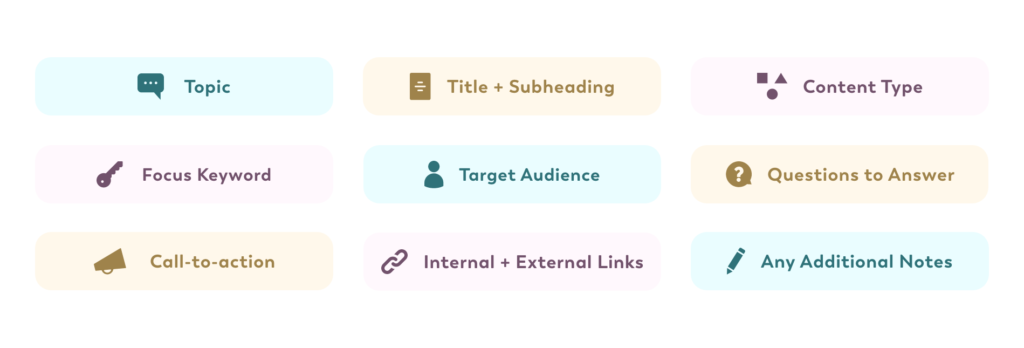We’ve seen a lot of…er, interesting things from our clients as content strategists and writers. Pages of unnecessary information. So much research and such extensive outlines that the client manager (or just the client themselves) could’ve written the piece themselves. Complicated brief formats that are hard to type in and harder to navigate when the creative process takes hold.
Our team is pretty badass, but we’re not so badass that we can read your mind and figure out how to bring that one piece of content to life exactly as you envision it. To get started on a piece of content, we need direction. We need content briefs. But… most content writers don’t need a process that is so overwhelmingly specific that it borders on micromanaging.
What is a content brief?
Never heard of a content brief before? Don’t panic. You’re probably already giving your writing team some sort of content brief without even knowing it.
Think of content briefs as a more official term for “instructions” or “an outline.” That’s their main role, after all. Content briefs collect and organize all the important information your writer needs to create a piece of content, in one handy document.
Why you should be using content briefs
Imagine a scenario where you give a writer directions for a blog post. You give them a topic and ballpark range for word count. You’ve worked with this writer before, so you’re pretty sure that’s all they need to write this post.
But wait, your writer emails you with a few questions. Do you have a focus keyword for the post? (Oh yeah! You forgot to mention that.) Is the blog’s tone of voice the same as your brand’s social media channels? (Well, no.) Do you have a specific call to action? (Yes…maybe.)
It doesn’t end there. There are some Slack messages, comments and suggestions in the Google Doc, and a couple more emails to boot. And that’s just the first draft. This entire dance starts all over again with the first rewrite.
We’re not saying the editing process won’t involve some questions, or that you won’t forget a detail every once in a while. But a thoughtfully written content brief will eliminate most, if not all, of those tedious, headache-inducing messages between you and your team.
Content briefs make the research, writing, and editing processes easier because they provide editorial guidance for each piece of content. But they also ensure that you are receiving content aligned with your goals, brand, and overall content strategy.
What to include in your content briefs
Now that we’ve covered how content briefs improve efficiency and communication, let’s talk about what you should include in every content brief. Put yourself in your content writer’s shoes. What information would you need to execute this piece of content? (Or, just take it from us writers and keep reading.)
Your mileage may vary based on your brand, audience, team, or the content piece itself, but generally a content brief should include:
- Topic for a short piece, or project summary for something longer
- Title and subheading suggestions
- Content type; e.g., blog, email, podcast show notes, sales page, etc.
- Focus keyword or phrase
- Target audience or buyer persona, if your brand has more than one
- Questions you’d like the content to answer
- Call-to-action (CTA)
- Internal and external links you’d like used
- Additional notes that explain anything else you want; e.g., writing style, tone of voice, related topics to include, sources to pull from

Keep in mind that your mileage may vary because of your writing team, too! Your in-house writer or the contractor you work with may need more or less information. You can tweak your content briefs according to everyone’s preferences.
Don’t leave content briefs out of the planning process
The cool thing about taking the time to figure out content briefs for your team? Once you know which details you need to include, all you have to do is build a content brief template that can be reused over and over for your future piece. Just plug in the details every time you plan a new piece of content.
Content briefs are also super helpful for when your team grows, or if you work with writers outside your organization who still need that information. It’s easy to forget what details someone new might need from you, but all you have to do is look at your content brief template and you’ll know what to include.
Get your content briefs right, and we bet your workflow will start running more smoothly. Your SEO will be mapped out, your writers will have everything they need to kick ass, and you’ll get that piece of content just the way you want it.

